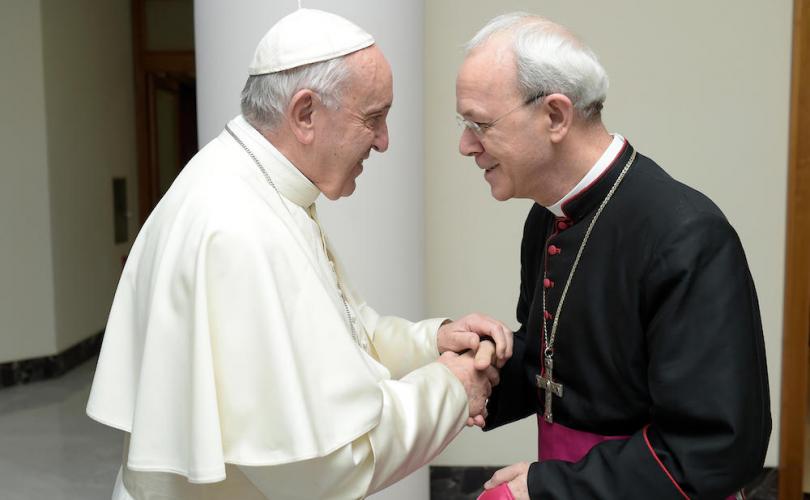On Married Priests
This from The Remnant, is a must read:
MARRIED PRIESTS? (In Defense of Ecclesiastical Celibacy)
Written by Roberto de Mattei | Remnant Columnist
Rate this item
(22 votes)
The Synod on the Amazon had among its main goals the abolition of ecclesiastical celibacy. The road, indeed the highway, is now paved. Pope Francis will define it in his Post-Synodal Exhortation, which is foreseen to be issued before the end of 2019.
In the concluding document of the Synod, the paragraph on married priests is the one that received the greatest number of opposing votes (128 placet vs. 41 non placet). The path that is being indicated is not that of so-called viri probati, married men who are ordained priests without leaving their families, but that of permanent deacons, that is, married men who have received the first grade of Holy Orders, which gives them the possibility of being ordained as priests.
We read in paragraph 111 of the chapter on Synodal Conversion:
“Many of the ecclesial communities of the Amazonian territory have enormous difficulties in accessing the Eucharist. Sometimes it takes not just months but even several years before a priest can return to celebrate the Eucharist, offer the sacrament of reconciliation or anoint the sick in the community. We appreciate celibacy as a gift of God (Sacerdotalis Caelibatus, 1) to the extent that this gift enables the missionary disciple, ordained to the priesthood, to dedicate himself fully to the service of the Holy People of God. It stimulates pastoral charity and we pray that there will be many vocations living the celibate priesthood. We know that this discipline “is not required by the very nature of the priesthood...although it has many reasons of convenience with it” (PO 16). [...] We propose to establish criteria and dispositions on part of the competent authority, within the framework of Lumen Gentium 26, to ordain priests suitable and esteemed men of the community, who have had a fruitful permanent diaconate and receive an adequate formation for the priesthood, having a legitimately constituted and stable family, to sustain the life of the Christian community through the preaching of the Word and the celebration of the Sacraments in the most remote areas of the Amazon region. In this regard, some were in favor of a more universal approach to the subject.”
The request for the abolition of celibacy comes from afar and is based on the false idea that the discipline that imposes it “is not required by the very nature of the priesthood.”
Fifty years ago, at the symposium of European bishops held in Chur, Switzerland, in July 1969, Cardinal Suenens, during his concluding conference, read a dramatic appeal by Hans Küng, asking to make the celibacy of priests no longer obligatory. Three years later, a group of theologians signed the manifest called “of the 33” [dei 33] asking for freedom from celibacy. This request was consistent with progressive theology’s understanding of the role of sexuality: an instinct that man should not repress by means of ascesis, but rather “liberate,” finding in sex a form of “realization” of the human person.
Father Hans Küng, 1973 (nice tie!)
 Since then, Küng, who today is 91, continues to repeat that the law of celibacy is the “root of all evil.” The argument that his followers employ is that celibacy is not a divine law, but only an ecclesiastical law, and as such it may be modified, in all or in part, by a Pope. The fundamental question therefore is to establish whether the law of ecclesiastical celibacy, beyond being an ecclesiastical practice for many centuries, descends from the divine-apostolic Tradition of the Church or not.
Since then, Küng, who today is 91, continues to repeat that the law of celibacy is the “root of all evil.” The argument that his followers employ is that celibacy is not a divine law, but only an ecclesiastical law, and as such it may be modified, in all or in part, by a Pope. The fundamental question therefore is to establish whether the law of ecclesiastical celibacy, beyond being an ecclesiastical practice for many centuries, descends from the divine-apostolic Tradition of the Church or not.
 Since then, Küng, who today is 91, continues to repeat that the law of celibacy is the “root of all evil.” The argument that his followers employ is that celibacy is not a divine law, but only an ecclesiastical law, and as such it may be modified, in all or in part, by a Pope. The fundamental question therefore is to establish whether the law of ecclesiastical celibacy, beyond being an ecclesiastical practice for many centuries, descends from the divine-apostolic Tradition of the Church or not.
Since then, Küng, who today is 91, continues to repeat that the law of celibacy is the “root of all evil.” The argument that his followers employ is that celibacy is not a divine law, but only an ecclesiastical law, and as such it may be modified, in all or in part, by a Pope. The fundamental question therefore is to establish whether the law of ecclesiastical celibacy, beyond being an ecclesiastical practice for many centuries, descends from the divine-apostolic Tradition of the Church or not.
We cannot ignore several foundational studies on this topic. The first, reprinted many times, is the essay by Cardinal Alfons Maria Stickler (1910-2007): Il celibato ecclesiastico. La sua storia e i suoi fondamenti teologici (Libreria Editrice Vaticana, Città del Vaticano 1994; English translation: The Case for Clerical Celibacy: Its Historical Development and Theological Foundations, Ignatius Press, San Francisco, 1995). The second, less well known but not less important, is the essay by Father Christian Cochini, Origines apostoliques du célibat sacerdotal (Le Sycomore-Lethielleux, Namur-Paris, 1981; English translation: The Apostolic Origins of Priestly Celibacy, Ignatius Press, San Francisco, 1990).
These works overturn the old thesis of Father Franz Xaver Funck (1840-1907), the German historian open to the suggestions of modernism, who at the beginning of the 20th century attempted to refute the great Orientalist Gustav Bickell (1838-1906). While Bickell defended the divine-apostolic foundation of the law of celibacy, Funck considered it to be an ecclesiastical practice that did not appear until at least the fourth century, that is, a merely historical law (that would therefore be reformable).

Cochini demonstrated that Funck did not make good use of the historical-critical method, judging as authentic a spurious document in which the bishop-monk Paphnutius, during the Council of Nicea (325), supposedly furiously contested the practice of continence for married priests. Today it has been proven that this text was fabricated, probably by those within the Novatian sect.
Stickler, for his part, emphasizes the hermeneutic error which, following Funck, confused the concept of ius (law) with lex (statute). The fact that prior to the fourth century there was no written law does not mean that there did not exist any obligatory juridical norm that enforced the continence of the clergy.
When Pope Siricius, in the years 385-386, with the decretals Directa and Cum in Unum formalized for the first time a discipline for clerics, establishing that bishops, priests, and deacons were held, without exception, to live permanently in continence, he was not introducing a new doctrine but codifying a Tradition that had been lived in the Church since her origins.
The theological progress consisted precisely in this: in the development of knowledge of a traditional precept, in this case ecclesiastical celibacy, that was able to be explained with better extension, clearness, and certainty. The critical editions and new documents of work on the first centuries that scholars have at their disposal today all point to this conclusion.
The only argument that has been advanced against this thesis revolves around a sophism that is always refuted and still always gets repeated: the fact that, in an apparent contradiction of the apostolic tradition, beginning with the Apostles themselves, the first Christians were married.
What is in question however is not the ordination of married men in the first centuries of Christianity. We know that this was a normal thing, if Saint Paul prescribed to his disciples Titus and Timothy that candidates for the priesthood were to have been married only one time (1 Tm 3:2; 3:12). Both Pope Siricius as well as Pope Innocent I insisted repeatedly that this did not mean that they could live after ordination in the desire to generate children but, on the contrary, that this was established “propter continentiam futuram / on account of the continence to be observed following [ordination].”
The central question is that of continence, refraining from every use of marital rights after priestly ordination. There is no need to confuse the state of matrimony with its use. Matrimony is an institution of a juridical-moral nature, raised by the Church to a sacrament, whose end is the propagation of the human race.

The use of matrimony is instead the physical union of two spouses, directed towards the generation of children. One may freely renounce this right while remaining married. And this is what the first Christians did, while remaining juridically married: they decided not to use matrimony, that is, they decided to live as celibates within the matrimonial state.
The word celibate, in this sense, does not indicate a state of life but rather the choice to forever abstain from sexual pleasure. In the first centuries the possibility of clergy living in the matrimonial state was recognized, but not the right to use matrimony. What was obligatory from the beginning was not the state of celibacy but continence, or abstinence from the generative act. The men who accepted the Gospel of Christ understood from the beginning the request of the Master to his Apostles that they must renounce even marriage for the sake of the Kingdom of heaven (Mt 19:12), and that, as disciples in the strictest and fullest sense, they must also leave father, mother, spouse, children, brother and sister (Lk 18:29, 14:26).
In the first centuries of the Church, access to Sacred Orders was open to those who were married, on the condition that they, with the consent of their wife, would renounce the use of matrimony and would practice a life of continence. The apostolic prescription of continence saw its logical development in the laws that progressively imposed the celibate state of life on priests.
The long series of papal interventions saw its crowning in the First Lateran Council, convoked by Pope Callistus II (1123), in which was promulgated a law, not only prohibiting matrimony for priests, but also establishing the invalidity of matrimony for one who had received sacred orders.
In the first millennium, the Eastern churches did not know this dogmatic-disciplinary development and remained as an exception to the Latin rule. Following this, in the schismatic Eastern churches, the ancient celibate discipline spread ever more widely, while the majority of the Eastern churches remained united or returned to union with Rome and accepted the Western discipline, even if for some Catholics, such as the Maronites and the Armenians, Rome tolerated their following of the ancient Greek custom. The fact is, however, that in the East priests cannot marry after ordination and only celibate priests are ordained as bishops, signifiying that the use of matrimony for one who had contracted it prior to ordination is a tolerated practice but certainly not set up as a model.
It is true that celibacy is based on an ecclesiastical law, but this is in turn based on a legal precedent with a divine-apostolic origin handed down from the Tradition of the Church. The conclusion, according to Cardinals Francesco Roberti and Pietro Palazzini, is that “the rule, conceived as deriving from divine/apostolic law, cannot be abrogated by ecclesiastical authority: therefore the Church would not have the right to abolish the celibacy of priests” (Dizionario di Teologia Morale, Roma, Studium, IV ed., 1968, I vol. p. 268, entry Celibato ecclesiastico).
Furthermore, attacks on celibacy have always accompanied the history of the Church. In 1941, for example, a book edited by the Protestant theologian Hermann Mulert, Der Katholizismus der Zukunft (Leipzig 1940) was placed on the Index of Forbidden Books, which included the option of making ecclesiastical celibacy optional. But there must be no illusion about this point: if the law of celibacy fails, the celibate priesthood falls with it and the way is opened towards the insitutionalization of ecclesiastical matrimony. Nor may the argument be used that chastity is impossible, since the Council of Trent condemned those who affirm it (session XXIX, canon 9).
It is true however that man cannot attain a life of perfect continence with his own power alone, for which reason God has not commanded it but only counseled it. Whoever freely chooses to follow this evangelical counsel, finds not in himself but in God the strength to live a life consistent with his choice. Celibacy remains, certainly, a sacrifice, and this, Father Cornelio Fabro has observed, “stands or falls with the character of the Catholic Church as the sols true Church of Jesus Christ.”
The Catholic priest, in fact, can and wants to sacrifice himself only for an absolute cause. But today the unicity of the Roman Church as the the true Church is placed into discussion and the concept of sacrifice has been abandoned, in the name of the search for pleasure at any cost. The priestly vocation also demands the total gift and the exclusive orientation of every concern to God and souls, it is incompatible with the division of the heart that is proper to one who has the care of a family.
John Paul II, in his Apostolic Exhortation Pastores Dabo Vobis, has affirmed that the will of the Church finds its ultimate motivation “in the link that celibacy has with sacred ordination, which configures the priest to Jesus Christ Head and Spouse of the Church (n. 29). And as Benedict XVI explained in his discourse to the Roman Curia on December 22, 2006:
The priest must truly know God from within and thus bring him to men and women: this is the prime service that contemporary humanity needs. If this centrality of God in a priest's life is lost, little by little the zeal in his actions is lost. [...] Celibacy, in force for Bishops throughout the Eastern and Western Church and, according to a tradition that dates back to an epoch close to that of the Apostles, for priests in general in the Latin Church, can only be understood and lived if is based on this basic structure.
Developing the pontifical Magisterium in his articles in L’Osservatore Romano and in his recent volume Il sigillo. Cristo fonte dell’identita del prete [The Seal: Christ the Source of the Identity of The Priest] (Cantagalli Siena 2010), Cardinal Mauro Piacenza reiterates that the theological root of celibacy traces back to the new identity that is given to him and is imprinted in the Sacrament of Holy Orders.
The root problem is therefore the role of the priest in postmodern society that Cardinal Piacenza discusses forecefully. The request for the abolition of celibacy is inserted into a context of secularization that is considered irreversible, despite the many contrary lessons present in history. Secularization means the loss of the concept of the sacred and of sacrfice and the assumption of “worldliness” as a value. But the modernization of the Church has led today to her “sexualization.”
Purity however is a virtue that propels one who practices it towards heaven, while sexuality ties human tendencies down to the earth. Many priests claim pleasure as a right and, if they do not obtain it officially, they exercise it in semi-clandestinity, many times under the benevolent and complicit eyes of their bishops. Their path is exactly the opposite of the one taken by the first Christians. Back then it happened that married men chose to embrace, with the priesthood, a life of absolute chastity and continence. Today what is happening is that priests who have consecrated their life to the Lord claim to be able to enjoy the pleasures of the world. This is not something new in the Church, which has lived through like a plague the concubinage of priests, that is, the fact that they live habitually more uxorio, as happened when Saint Peter Damian wrote the fiery Liber Ghomorranus.
 Archbishop Athanasius Schneider has reaffirmed many times that Pope Francis has the serious duty of reaffirming ecclesiastical celibacy as a law for the entire Church. If this does not happen, the resistance of Catholics against this pontificate will increase. The way to follow, just like in the time of Saint Peter Damian, is that of a profound moral reform, analagous to the Cluniac and Gregorian reform of the eleventh century. And if we want to review the reasons to defend priestly celibacy, in the first place we would have to say that we are not talking about an ecclesiastical law, but of the will of Christ himself, handed down through the Apostles to the Church; in the second place that the world needs priests who do not “go along” with suffering humanity, but who conquer it, mirroring Christ and posing as a model and guide to souls, who today are thirsting for the absolute more than ever.
Archbishop Athanasius Schneider has reaffirmed many times that Pope Francis has the serious duty of reaffirming ecclesiastical celibacy as a law for the entire Church. If this does not happen, the resistance of Catholics against this pontificate will increase. The way to follow, just like in the time of Saint Peter Damian, is that of a profound moral reform, analagous to the Cluniac and Gregorian reform of the eleventh century. And if we want to review the reasons to defend priestly celibacy, in the first place we would have to say that we are not talking about an ecclesiastical law, but of the will of Christ himself, handed down through the Apostles to the Church; in the second place that the world needs priests who do not “go along” with suffering humanity, but who conquer it, mirroring Christ and posing as a model and guide to souls, who today are thirsting for the absolute more than ever.
Translated for The Remnant by Giuseppe Pellegrino




Comments
Post a Comment